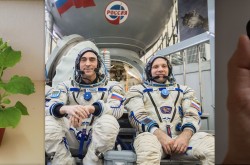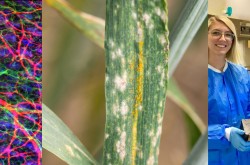3 things you should know — August edition


Meet Renée-Claude Goulet, Jesse Rogerson, and Kyrke Gaudreau.
This all-star trio works as Ingenium’s science advisors, providing expert advice on key subjects relating to our three museums — the Canada Agriculture and Food Museum, the Canada Aviation and Space Museum, and the Canada Science and Technology Museum.
In this new monthly blog series, Ingenium’s science advisors offer up three quirky nuggets related to their area of expertise. For the August edition, they tackled how perspectives are shifting when it comes to Canada’s food system, how new technology is revolutionizing air traffic surveillance, and how trees could play a major role in mitigating climate change.
New technology takes air traffic surveillance to new heights
How do airplanes get “lost”? Don’t we have technology to keep that from happening?
Fortunately, we do now...but this hasn’t always been the case. A Canadian company, NAV CANADA, has just led the development and deployment of the next generation of air traffic surveillance: space-based Automatic Dependent Surveillance - Broadcast (ADS-B). This new technology will make it impossible to lose aircraft flying anywhere on Earth. But before we get into that, let’s talk about how we currently track commercial flights.
When you get into a plane and take off from an airport, the location of the plane and the direction your plane is taking is being tracked by a network of Air Traffic Controllers (ATCs). They track you through a variety of surveillance techniques. First, radio waves are pulsed into the air by dishes on the ground; the radio waves bounce off the aircraft and return to the source. This is conventional RADAR. Secondly, commercial aircraft have transponders on board, which broadcast a read-out of pertinent flight data — such as a unique identifier, altitude, and ground speed — to receivers on the ground. Finally, ADS-B allows an aircraft to broadcast its GPS location to receivers on the ground. These techniques can be used in combination or on their own.
Unfortunately, these types of surveillance are completely reliant on ground-based infrastructure, which does not exist in very remote areas or over oceans. When flying in those un-surveilled regions, the location of aircraft is only known when the pilots read out their GPS location to ATCs by voice over high-frequency radios.
In order to fix this problem, Aireon, a company majority-owned by NAV CANADA, has created the first ever space-based ADS-B, which allows aircraft to broadcast their GPS locations to ATCs via satellites, as opposed to via ground-based receivers.
Aireon’s ADS-B technology is aboard each of the 75 Iridium NEXT spacecraft, a network of communication satellites that are evenly spread out around the globe at a height of 780 km. The last of the Iridium NEXT satellites were launched in early 2019, and the Aireon tech is already being used for the busiest oceanic airspace in the world: the trans-atlantic corridor.
This is a major leap forward in air traffic surveillance, and it’s exciting to know that Canada has played a central role in its development.
By Jesse Rogerson

Trees and degrees: The climate of change
In 2016, the world came together for the historic Paris Accord, which pledged to limit global warming to 2 degrees Celsius, with an aspirational goal of 1.5 degrees Celsius. While these temperature changes may seem small, make no mistake: even 1.5 degrees of change will be devastating. As James Temple notes in MIT Tech Review notes, “1.5 C of warming could already be enough to expose 14 per cent of the global population to bouts of severe heat, melt nearly 2 million square miles (5 million square kilometers) of Arctic permafrost, and destroy more than 70 per cent of the world’s coral reefs.” And 2 degrees is much, much worse. So, while commendable, the Paris Accord is not a roadmap for success as much as a desperate plan to avoid the worst.
As it turns out, the worst is nearly upon us. A recent article from the journal Nature has shown that with our currently installed global infrastructure (power plants, transportation systems, factories, etc.), we are already locked in to a global warming of 1.5 degrees Celsius. That means that even if we stopped building any new greenhouse gas-emitting technologies tomorrow, 1.5 degrees C is the best we can do. To lower that number, we must shut down power plants and industries — well before the end of their useful lives. Given how much of our society still runs on fossil fuels, it all looks pretty dire.
When faced with a challenge as daunting and demoralizing as climate change, it’s important to see the forest for the trees. And as luck would have it, a recent article in Science argued that planting trees can play a major role in mitigating climate change by sucking billions of tonnes of CO₂ right out of the air. It will take a lot of trees, about 1 trillion of them (which amounts to the surface area of the United States). But we are in the age of thinking big. Of course, tree planting is not a substitute for reducing greenhouse gas emissions in the first place, but it can help us get to where we need to be.
By Kyrke Gaudreau

Food guides and policies: Shifting perspectives in Canada
By now, Canadians are getting familiar with the new — albeit slightly controversial — food guide, released earlier this year by Health Canada. Intended to help Canadians make informed choices when it comes to their diet, this new guide eliminates many of the concepts some of us have grown up knowing as tenets of nutrition. Gone are the ideas of portions and food groups; and there’s no more measuring slices of cheese against dominoes. With its divided dinner plate visual, the new food guide is easier to follow and less rigid — and this may be a great thing for overall adoption
Love it or hate it, Canada’s Food Guide brings something new to the table (pun intended!); it takes into account the emotional and social aspects of eating. In fact, at the governmental level in Canada, we are seeing a broadening of the way we think about eating to include not only the functional — nourishing our bodies — but a welcome inclusiveness of the various other aspects of our lives which are so intertwined with food.
This shift in perspective extends over to another governmental agency that has a primordial role in our food system: Agriculture and Agri-food Canada. In June, the department announced Canada’s first food policy – a set of principles meant to guide decisions and actions in the public, private, and non-profit sectors, to create a healthier and more sustainable food system. With an investment of $134.4M over five years, the policy has four areas of focus which go far beyond “food production.” With this policy, we see investment in access to healthy food for all Canadians, food security in Northern and Indigenous communities, promotion of Canadian agriculture products, and even food waste reduction.
How this will all unfold is yet to be determined, however, it is interesting to know that the tides are changing when it comes to how we think about food — and this may spark a whole new era for Canada’s food system.
By Renée-Claude Goulet
Looking to read more quirky science nuggets? Check out the July edition of “3 things you should know.”














